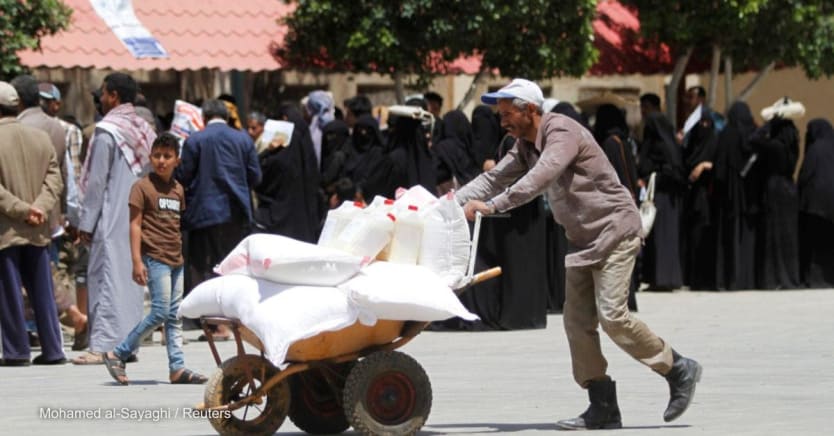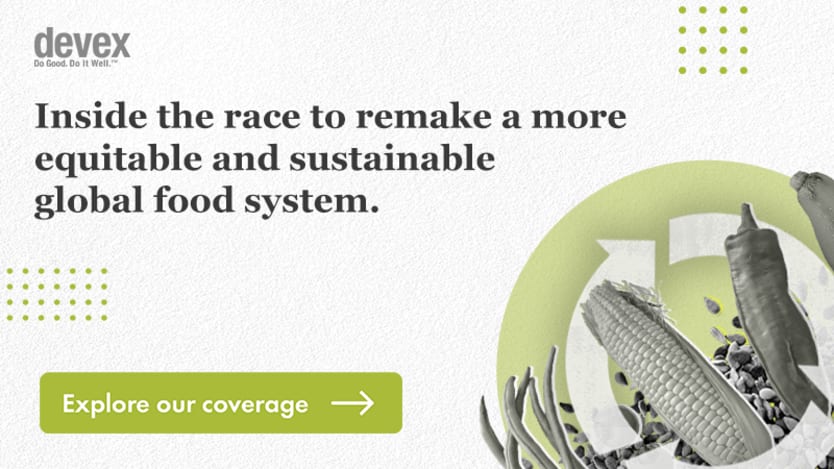
While accelerated deployment of resources into Yemen has temporarily slowed the food insecurity crisis, sustained funding is needed to keep people out of famine, the United Nations’ highest-ranking official in the country told Devex.
Get the inside track on how agriculture, nutrition, sustainability, and more are intersecting to remake the global food system in this weekly newsletter.
At the start of this year, roughly 50,000 people in Yemen were experiencing famine — the fifth and most severe phase of food insecurity in the IPC Acute Food Insecurity classification system. Five million people were in the fourth phase, indicating “Emergency” conditions, and 11 million others were in the third phase with “Crisis” levels of food insecurity. The U.N. currently reaches about 13 million people in the country with food assistance.
“We’ve stopped the move towards famine temporarily, but I emphasize the last word because ‘temporary’ is fragile and needs to be sustained,” said David Gressly, U.N. resident coordinator and humanitarian coordinator for Yemen.
“It’s very tenuous. I think with additional funding again we’re good for a few more months, but after that …” he said, trailing off. “We’re constantly at the edge in terms of the pipeline of financing — as well as food supply — coming in. So those streams need to continue coming.”
Gressly, who was in Washington last week to advocate for continued attention to the seven-year-long conflict that has left more than 20 million Yemenis in need of humanitarian assistance, said fundraising so far in 2021 has outpaced that of last year. A side event at the U.N. General Assembly last month raised around $600 million, but the appeal remains about $1 billion short of the requested $3.6 billion, he explained. Last year’s appeal was only 60% funded.
“It’s not just a question of how much; it’s the ‘how much [and] when,’” Gressly said. “For particularly WFP [the World Food Programme], that's critical — and UNICEF — for malnutrition. It’s critical that pipeline not be broken so that they can sustain the higher rations. If they cannot sustain, then at some point they will have to cut back.”
For the first time, Gressly said, the U.N. has been able to carry out detailed assessments across Yemen to determine humanitarian needs. The process this year has been facilitated by negotiations with parties to the conflict for permission to move about in both the north and the south of the country.
Rather than logistics or security issues, the more common impediments to freedom of movement for humanitarian personnel are administrative and bureaucratic hurdles in areas with multiple factions claiming authority, Gressly said. Warring parties frequently use their ability to disrupt the flow of aid to influence political support, but maintaining strict neutrality in the conflict is central for the U.N. to meet humanitarian needs, he added.
Having a clear picture of the population’s access to nutrition, health, water, sanitation, education, and protection will help the humanitarian system plan its response for 2022, and Gressly said he hopes a detailed needs assessment will motivate continued giving to Yemen.
“To actually attract humanitarian assistance, you need to actually provide access, assessments before donors will contribute,” he said. “That understanding is better understood [by parties to the conflict in Yemen]. We’re seeing better cooperation as a result. But it still requires frankly continuous negotiation for access for each of these things. Every day is a new negotiation.”
The U.N. needs a more detailed view of the country’s economic situation, Gressly said, because the state of the market often determines access to basic services. Many people in Yemen are unable to obtain food not because it is unavailable for purchase, but because the costs of importing it into the war-torn country inflate prices beyond what an average household can afford.
Opening ports to their full capacity could help reduce distribution costs of basic supplies, such as fuel for cooking.
“We’re constantly at the edge in terms of the pipeline of financing — as well as food supply — coming in. So those streams need to continue coming.”
— David Gressly, resident coordinator and humanitarian coordinator for Yemen, United Nations“It’s an economic crisis that really is driving this humanitarian crisis,” Gressly said. “So while we would like to see political settlement that I think would start to reverse all of these factors — until that happens, we need to see continued humanitarian support on a parallel track that deals with some of the economic constraints that inhibit employment, that inhibit payment of salaries to civil servants [and] drive up food import costs, so that we can better balance food availability [and] affordability.”
Continued degradation of the economy will severely impact the ability of the Yemeni population to live successful lives in the future, according to Gressly. Destroyed infrastructure, including roads and schools, will make it extremely challenging for the country to recover once a political solution to the conflict is reached. Human capital will also be severely impacted, he said, with the effects of malnutrition to extend beyond the current moment for children who do not have enough to eat.
“Stunting is an issue at this point in time and that endures for decades,” Gressly said. “This is where Yemen is today. Its future is being compromised by this conflict. Not just the present [but] the future is also at risk.”









